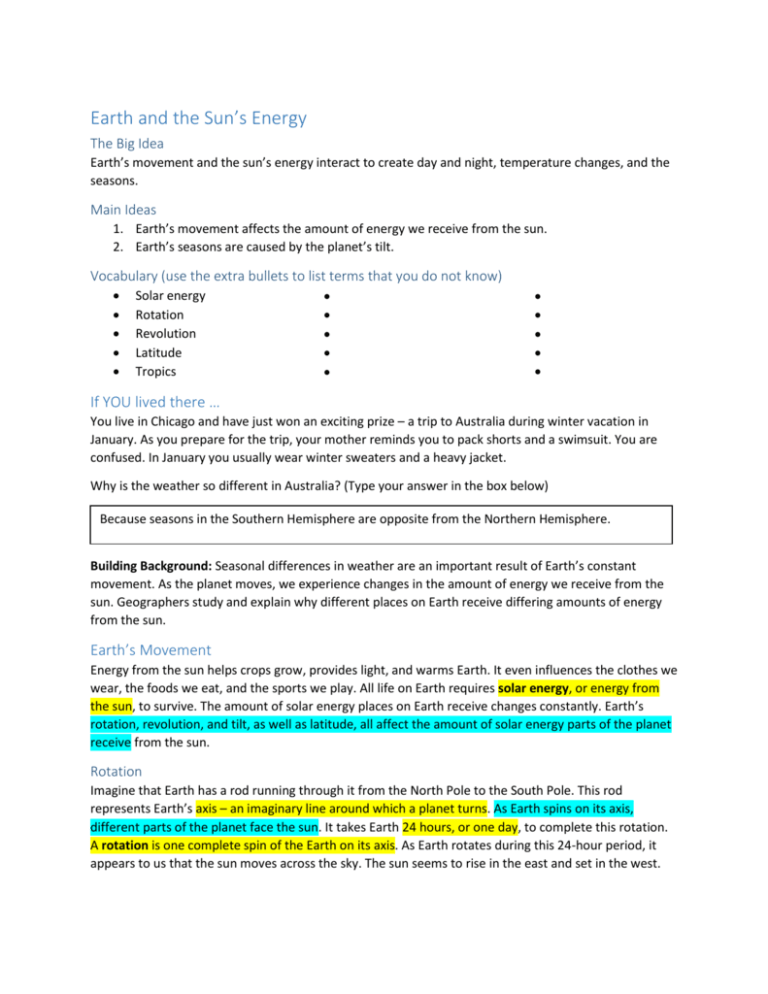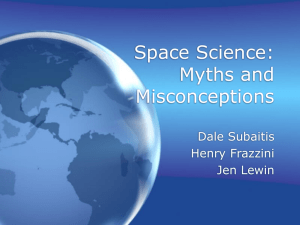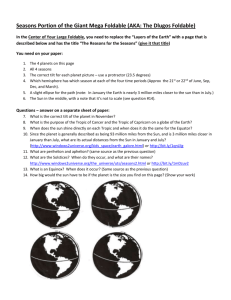Earth and the Sun`s Energy
advertisement

Earth and the Sun’s Energy The Big Idea Earth’s movement and the sun’s energy interact to create day and night, temperature changes, and the seasons. Main Ideas 1. Earth’s movement affects the amount of energy we receive from the sun. 2. Earth’s seasons are caused by the planet’s tilt. Vocabulary (use the extra bullets to list terms that you do not know) Solar energy Rotation Revolution Latitude Tropics If YOU lived there … You live in Chicago and have just won an exciting prize – a trip to Australia during winter vacation in January. As you prepare for the trip, your mother reminds you to pack shorts and a swimsuit. You are confused. In January you usually wear winter sweaters and a heavy jacket. Why is the weather so different in Australia? (Type your answer in the box below) Because seasons in the Southern Hemisphere are opposite from the Northern Hemisphere. Building Background: Seasonal differences in weather are an important result of Earth’s constant movement. As the planet moves, we experience changes in the amount of energy we receive from the sun. Geographers study and explain why different places on Earth receive differing amounts of energy from the sun. Earth’s Movement Energy from the sun helps crops grow, provides light, and warms Earth. It even influences the clothes we wear, the foods we eat, and the sports we play. All life on Earth requires solar energy, or energy from the sun, to survive. The amount of solar energy places on Earth receive changes constantly. Earth’s rotation, revolution, and tilt, as well as latitude, all affect the amount of solar energy parts of the planet receive from the sun. Rotation Imagine that Earth has a rod running through it from the North Pole to the South Pole. This rod represents Earth’s axis – an imaginary line around which a planet turns. As Earth spins on its axis, different parts of the planet face the sun. It takes Earth 24 hours, or one day, to complete this rotation. A rotation is one complete spin of the Earth on its axis. As Earth rotates during this 24-hour period, it appears to us that the sun moves across the sky. The sun seems to rise in the east and set in the west. The sun, however, does not move. It is actually Earth’s rotation that creates the sense of the sun’s movement. Earth’s rotation also explains why day changes to night. As you can see in the illustration, solar energy strikes only the half of Earth facing the sun. Warmth and light from the sun create daytime. At the same time, the half of the planet facing away from the sun experiences the cooler temperatures and darkness of night. Earth’s rotation causes regular shifts from day to night. As a result, levels of solar energy on Earth constantly change. Revolution As Earth spins on its axis, it also follows a path, or orbit, around the sun. Earth’s orbit around the sun is not a perfect circle. Sometimes the orbit takes Earth closer to the sun, and at other times, the orbit takes it farther away. It takes 365¼ days for Earth to complete one revolution, or trip around the sun. We base our calendar year on the time it takes Earth to complete its orbit around the sun. To allow for the fraction of a day, we add an extra day – February 29 – to our calendar every four years. Tilt and Latitude Another factor affecting the amount of solar energy we receive is the planet’s tilt. As the illustration shows, Earth’s axis is not straight up and down. It is actually tilted at an angle of 23½ degrees from vertical. At any given time of year, some locations on Earth are tilting away from the sun, and others are tilting toward it. Places tilting toward the sun receive more solar energy and experience warmer temperatures. Those tilting away from the sun receive less solar energy and experience cooler temperatures. A location’s latitude, the distance north or south of Earth’s equator, also affects the amount of solar energy it receives. Low-latitude areas, those near the equator like Hawaii, receive direct rays from the sun all year. These direct rays are more intense and produce warmer temperatures. Regions with high latitudes, like Antarctica, are father from the equator. As a result, they receive indirect rays from the sun and have colder temperatures. Reading Check: Finding the Main Idea. What factors affect the solar energy Earth receives? (type your answer in the box below) The Seasons Does the thought of snow in July or 100-degree temperatures in January seem odd to you? It might if you live in the Northern Hemisphere, where cold temperatures are common in January, not July. The planet’s changing seasons explain why we often connect certain weather with specific times of the year, like snow in January. Seasons are periods of the year that are known for a particular type of weather. Many place on Earth experience four seasons – winter, spring, summer, and fall. These seasons are based on temperature and the length of the day. In some parts of the world, however, seasons are based on the amount of rainfall. Winter and Summer The change in seasons is created by Earth’s tilt. As you can see in the illustration below, while one of the Earth’s poles tilts away from the sun, the other tilts toward it. During winter part of the Earth is tilted away from the sun, causing less direct solar energy, cool temperatures and less daylight. Summer occurs when part of the Earth is tilted toward the sun. This creates more direct solar energy, warmer temperatures, and longer periods of daylight. Because of Earth’s tilt, the Northern and Southern hemispheres experience opposite seasons. As the North Pole tilts toward the sun in summer, the South Pole tilts away from it. As a result, the Southern Hemisphere experiences winter. Likewise, when it is spring in the Northern Hemisphere, it is fall in the Southern Hemisphere. Focus on Culture: The Midnight Sun Can you imagine going to sleep late at night with the sun shining in the sky? People who live near the Arctic and Antarctic Circles experience this every summer, when they can receive up to 24 hours of sunlight a day. The time-lapse photo below shows a typical sunset during this period – except the sun never really sets! This phenomenon is known as the midnight sun. For locations like Tromso, Norway, this means up to two months of constant daylight each summer. People living near the Earth’s poles often use the long daylight hours to work on outdoor projects in preparation for winter, when they can receive 24 hours of darkness a day. -----------------------------------------------------------------------------------------------------------------------------------------Predicting: how might people’s daily lives be affected by the midnight sun? Spring and Fall As Earth orbits the sun, there are periods when the poles tilt neither toward nor away from the sun. These periods mark spring and fall. During the spring, as part of Earth begins to tilt toward the sun, solar energy increases. Temperatures slowly start to rise, and days grow longer. In the fall, the opposite occurs as winter approaches. Solar energy begins to decrease, causing cooler temperatures and shorter days. Rainfall and Seasons Some regions on Earth have seasons marked by rainfall rather than temperature. This is true in the tropics, regions close to the equator. At certain times of the year, winds bring either dry or moist air to the tropics, creating wet and dry seasons. In India, for example, seasonal winds called monsoons bring heavy rains from June to October and dry air from November to January. Reading Check: Identifying Cause and Effect. What causes the seasons to change? (type your answer in the box below) Summary and Preview: Solar energy is crucial for all life on the planet. Earth’s position and movements affect the amount of energy we receive from the sun and determine our seasons. Next, you will learn about Earth’s water supply and its importance to us. Section 1 Assessment Reviewing Ideas, Terms, and Places 1. Vocabulary a. Identify: What is solar energy and how does it affect Earth? b. Analyze: How do rotation and tilt each affect the amount of solar energy that different parts of Earth receive? c. Predict: What might happen if Earth received less solar energy than it currently does? 2. Concepts a. Describe: name and describe Earth’s seasons. b. Contrast: how are seasons different in the Northern and Southern hemispheres? c. Elaborate: How might the seasons affect human activities? Critical Thinking 3. Identifying Cause and Effect: Use your notes to create a cause-and-effect diagram that explains the seasons. Writing 4. Describing the Seasons: What are the seasons like where you live? In your notebook, jot down a few notes that describe the changing seasons in your area.








